March 23, 2006
Immediately after the
blast in Samarra targeting the shrines of Ali Al-Hadi and Hassan Al-Askari, men dressed in black, and in large
number, attacked Sunni mosques and areas. In some attacks, cars of the Ministry of Interior were used; like
the attack on the mosque of Fandi Al-Kubaisi in west Baghdad where 14 police commandos were killed when
citizens of Al-Shurta district defended their mosque.
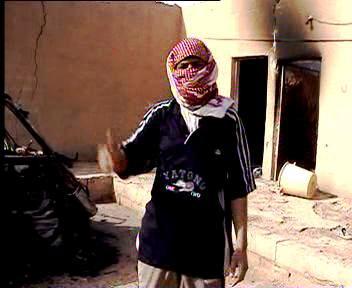 Black-clad
militias and police commandos also attacked Al-Fursan (bani ziyad), a little Sunni village located in
Nahrawan, south east of Baghdad. I decided to go there to film when I heard that some from the Iraqi Red
Crescent would visit the village and bring aid 03 March 2006. I went with two ambulances and a truck carrying
lanterns, kerosene, blankets, etc. I was sitting in the second ambulance and trying to film the road when a
man from the Red Crescent advised me not to given the checkpoints along the way, and as civilian spies were a
danger also. I filmed four police cars burnt out on the road. There was a cameraman from the Baghdad office
of the Iraqi Islamic Party TV channel with us.
Black-clad
militias and police commandos also attacked Al-Fursan (bani ziyad), a little Sunni village located in
Nahrawan, south east of Baghdad. I decided to go there to film when I heard that some from the Iraqi Red
Crescent would visit the village and bring aid 03 March 2006. I went with two ambulances and a truck carrying
lanterns, kerosene, blankets, etc. I was sitting in the second ambulance and trying to film the road when a
man from the Red Crescent advised me not to given the checkpoints along the way, and as civilian spies were a
danger also. I filmed four police cars burnt out on the road. There was a cameraman from the Baghdad office
of the Iraqi Islamic Party TV channel with us.
After some time we came to a Shia village called Al-Maahad.
I knew the village was Shia when I saw the black, red and green flags hanging from the houses; they seemed a
happy people, and I thought that the village was far from the one attacked as there was nothing on the faces
of the people of Al-Maahad to indicate that a massacre had happened nearby. We stopped to ask directions to
Al-Fursan, went on and stopped again; there were Americans this time, about 200 metres ahead of us.
Immediately I thought that they might shoot, although they could see we were in ambulances trying to give a
medical care. They attacked ambulances before, many times, in Fallujah. We choose among us three people to go
talk to them; the men walked a few steps towards the Americans who turned their humvee very fast and drove
away from us. "This doesn’t feel right," I thought.
We got into the ambulances and moved ahead. "They’ve
made an ambush for us," I said. "They need no ambush to get us," a man from the Red Crescent replied. The
humvee was parked under trees on the right side pointing it’s machine gun towards us; I did not see the other
humvees, "It’s really an ambush," I thought.
 We
continued moving ahead, passing the first houses of the village, which were burnt. Then we stopped in front
of a mosque. I got out and started filming. From inside there were many holes from BKC
machine guns in the walls of the mosque and some clear damage to the structure. I heard someone say, "Do not
film [my face]." As I left the mosque I found four young people; they seemed exhausted, pale and angry, as
though they had been sleeping outside. I found out later that they were guarding their village from looters.
One of them was very angry. He was shouting, "Now you come after three days, bringing help: to whom shall we
give it? No one is in the village. All left or died."
We
continued moving ahead, passing the first houses of the village, which were burnt. Then we stopped in front
of a mosque. I got out and started filming. From inside there were many holes from BKC
machine guns in the walls of the mosque and some clear damage to the structure. I heard someone say, "Do not
film [my face]." As I left the mosque I found four young people; they seemed exhausted, pale and angry, as
though they had been sleeping outside. I found out later that they were guarding their village from looters.
One of them was very angry. He was shouting, "Now you come after three days, bringing help: to whom shall we
give it? No one is in the village. All left or died."
I asked to talk to him privately; we went to one
corner of the mosque and I said, "This tape that I will film will go to Al-Jazeera; what you say and what I
film will be shown to millions. Millions will hear you if you talk." The man silently looked at me and then
said "Swear with almighty Allah that this tape is for Al-Jazeera." I did. "Actually I depended on a friend
who knows Al-Jazeera reporters in Baghdad," the man asking his friend to give him his hat so as to use as a
mask when we started the interview. I thought that he might be a militant and that he would kill me as I
belonged myself to Al-Jazeera, but signs of sadness and tiredness were clear on his face; he could not be
like that if he was a militant.
The man left me and joined the group of Red Crescent
members and Baghdad TV journalists who were talking, while I decided to start filming. I went to the first
house where I was attacked by a dog that refused to let me pass. I got in to the house, nonetheless; it was
burnt from inside and the roof had fallen in. It seemed that someone had used explosives to destroy the
house. Furniture was mixed with the wreckage of the roof. I saw a baby bed — I filmed it — then went out, to
see the four men waiting for me. It seemed they had accepted that I was serious about filming their disaster.
I made an interview with the tall man; he covered his face except his eyes, and stood before the burnt house
and car.
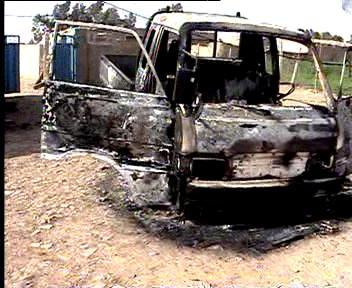 He
said, "Around 50 Chevrolet of the commandos of the police attacked our village; they were wearing black, they
killed 8 people and kidnapped 22. We may find their bodies somewhere." The man said that the militants came
from different areas, confirming that they were Mahdi Army and Badr Brigades. The four men told me that they
would show me more of the burnt houses so I accompanied them. The Baghdad TV cameramen bothered me a lot; he
was standing close, filming me from behind. I did not want to be shown on TV, especially while I was carrying
my camera and filming. Everyone is a target, but those shown on TV are even more so.
He
said, "Around 50 Chevrolet of the commandos of the police attacked our village; they were wearing black, they
killed 8 people and kidnapped 22. We may find their bodies somewhere." The man said that the militants came
from different areas, confirming that they were Mahdi Army and Badr Brigades. The four men told me that they
would show me more of the burnt houses so I accompanied them. The Baghdad TV cameramen bothered me a lot; he
was standing close, filming me from behind. I did not want to be shown on TV, especially while I was carrying
my camera and filming. Everyone is a target, but those shown on TV are even more so.
I asked the men to go deeper in the village. The
cameraman was afraid and returned to our ambulances. I was afraid also. The scene was horrible. The village
was deserted, and destroyed. All the houses were burnt — both clay and concrete houses were burnt. Black soot
was everywhere, over windows and doors. Cars were burnt; trucks were burnt. Animal carcasses were everywhere.
The people who had come killed everything alive. They raided the villages many times, so they might raid it
while we were there. I was suspicious of the people of Al-Mahaad village.
The tall man told me that after the raid the families
of the village settled in an area near the village. From there they saw people from the Shia areas come to
loot their village; he said: "We had to go back and kick them out." I understood later that the militants
were near the village, waiting for the village people to return to kill them. But the village people called
on friends from other Sunni villages to come and help them. They came and a bloody battle ensued, leaving
four police cars burnt.
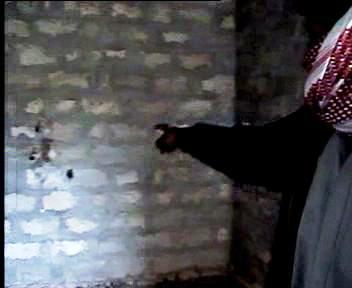 I
went on a high place and took a wide shot of the houses. The village was divided into groupings, each
containing four or five houses close to each other, each group 100 metres from the others. The men showed me
the marks of BKC bullets and Kalashnikovs. It seemed that the attackers shot on the
houses before entering them.
I
went on a high place and took a wide shot of the houses. The village was divided into groupings, each
containing four or five houses close to each other, each group 100 metres from the others. The men showed me
the marks of BKC bullets and Kalashnikovs. It seemed that the attackers shot on the
houses before entering them.
We went to one house were an entire family was
executed. I filmed it from inside (the footage was shown on Al-Jazeera later). At that moment the Americans
came. They passed near the house. I concealed myself, changed the tape in the camera, waited for the
Americans to leave, and started filming once more.
The men took me then to a house where one of them
said that a 10 year old, who had run from the attackers, had concealed himself in a room near the house. The
man pointed to the room and said, "Let me show you what they did."
He entered the room before me — I was filming — and
said, "Come, come." He showed me a spot of blood on the ground of the room and said that here the attackers
had executed the child. The man was very nervous. One other man said, "See the blood on the wall; there were
a four or five holes and blood spots on the wall." It seems the child had been forced against the wall and
shot in the head. The holes were at a height 125-130 centimetres, the height of the child. We saw more bullet
holes from BKC machine guns.
The men said they found the child’s body in nearby
grasses. "We buried him half an hour before you came." The men also buried the bodies of eight others,
including a woman, old men and children from the village.
 Then
we went running very fast towards another house and another executed person; the imam of the village mosque,
Sheikh Abu-Ayse. The men showed me the place were the militants told Abu-Ayse to
kneel, shooting him with a BKC machine gun and a Kalashnikov. They showed me a large bloodstain on the ground
and bullet holes from the gunfire. They said that they had killed him in front of his family.
Then
we went running very fast towards another house and another executed person; the imam of the village mosque,
Sheikh Abu-Ayse. The men showed me the place were the militants told Abu-Ayse to
kneel, shooting him with a BKC machine gun and a Kalashnikov. They showed me a large bloodstain on the ground
and bullet holes from the gunfire. They said that they had killed him in front of his family.
I forgot to ask them what happened to them, the man
saying, 'Jafaari wants to kick Sunnis out of Baghdad; it’s a war against Sunnis. Why does he send the Wolf
Brigade, the Scorpion Brigade, the Lion Brigade, the Falcon Brigade and Mahdi Army wearing black, killing us?
They talk about terrorism, but what is this?" The man threw the cases of bullets he had been holding on a car
in anger, and then showed me his cow’s carcass. The attackers had shot the cow with a BKC machine gun. There
was a gaping hole in its neck. The other man said, "Here, they are our police, killing our animals with BKCs;
but this is not terrorism. They give them BKCs to kill our animals too … "
Around this time the people at the ambulances started
calling me on a loud speaker. It was late and we ran fast towards the cars. I got in the ambulance, they got
in a truck and left. I went to Al-Jazeera, gave them the tapes. They showed part of the tapes, but none of
the interviews.
Appeal For Help - Sectarian Cleansing and
Coercive Displacement
Abdul Wahab Al Obeidi
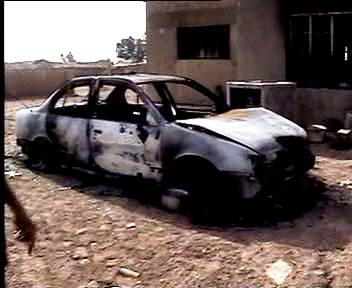 Undeclared
sectarian war and bloodshed are still underway in Iraq, regardless of non-stop calls to put an end to them,
which are warning against being dragged into civil war, which will definitely end up with casualties from all
parties involved.
Undeclared
sectarian war and bloodshed are still underway in Iraq, regardless of non-stop calls to put an end to them,
which are warning against being dragged into civil war, which will definitely end up with casualties from all
parties involved.
Below are the details of this ongoing war:
On March 2, 2006, an envoy of the Voice of Freedom for Human Rights and the Red Crescent
visited Al-Fursan Village, located near An-Nahrawan in Madaen. It comprises of 60 brick and mud houses,
inhabited by more than 60 Sunni families. The village is surrounded by a number of predominantly Shiite
villages, decorated with black and red flags.
on February 27, 2006, Al-Fursan village was attacked by hordes of men in black, who were
driving cars of the ministry of interior and state-backed militias. A large number of the villagers fled
their homes. Eight people, including the Imam of the village mosque, whose name is Abu Aisha, and a ten
year-old boy called Adnan Midab, were executed. Please find the attached photograph of the room in which
Adnan was hiding and was later killed. A number of dead animals (sheep, cows and dogs) were also shot at by
the attackers.
The village mosque was sabotaged and burned down like almost all the houses in the
village. When the relief workers and VOF envoy were in the village, four men, who were hiding outside the
village came back stealthily to recount the details of the attack. They stated that the perpetrators used
machinegun, Kalashnikov, explosives and fuel to carry out the attacks. Given the fact that the villagers
thought that it was the security forces, they did not take any precautionary measures to protect themselves.
 The
aforementioned men, who were hiding outside the village showed us where the dead bodies of men, women and a
child were buried.
The
aforementioned men, who were hiding outside the village showed us where the dead bodies of men, women and a
child were buried.
We saw the room, where ten-year old Adnan Midab was shot dead. We also saw the burned down
cars of the villagers.
Young men stated that they have been repeatedly harassed in order to force them into
leaving their village. After this attack, all the remaining families left to other places in Dyala and
Baghdad.
We have taken photographs of a large number of places in the village. There is a number
of isolated predominantly Sunni villages (Al-Batta, Al-Mujamma', etc, whose people were harassed by men of
the ministry of interior and militias, backed by foreigners. The latter villages are attacked on a regular
basis, but it was impossible for our staff to get into them, due to security restrictions.
The above is but the tip of the iceberg. These practices are organized and carried out on
a regular basis within towns, rural villages and suburbs. Civilians are asking for international forces to
protect them.
It is worth noting that the authorities are turning a blind eye on the perpetrators and
terrorists who have been carrying out these attacks. Failure to protect the civilians will only make things
worse.
Initial Statistics
The coercive displacement practiced by the ministry of interior, the state-backed militias
and foreigners against the people of Nahrawan is on the increase. The number of the Sunni families who have
fled their homes is as follows:
Al-Jboor Village, 50 families
Jabir Hummadi Village, 60 families
Shakha Village No. 5, 12 families
Shakha Village No. 7, 30 families
Al-Khalisa Village, 50 families
Al-Fursan Village, 60 families
Jasim Ibrahim Al-Battawi Village, 33 families
Bani Zed Village, 100 families
Al-Mujamma' Village, 100 families
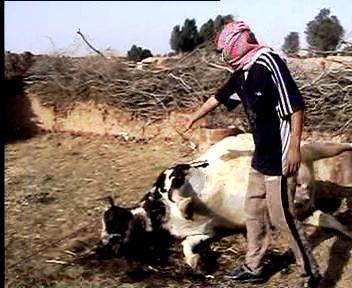
The
tragedy is mounting.
People are deprived of basic needs.
The aid workers are helpless.
The UN and
humanitarian NGOs must act and do the following:
a) - Send a Fact Finding Committee of the UN, the Arab League or International
Organizations.
b) - Send Peacemaking forces to protect the civilians and put an end to genocides,
sectarian cleansing and coercive displacement.
c) - Control the east borders of Iraq to stop the acts of terrorism perpetrated by
foreigners, who have been pouring to Iraq through the Iranian borders and raid and search the villages
harbouring them.
d) - Launch a relief program by neutral trusted parties.
The UN Assistance Mission
for Iraq (UNAMI), Human Rights Report, 1 January– 28 February 2006, states:
"Serious
allegations have been received by UNAMI Human Rights Office regarding the actions of some segments of the
security forces, in particular the police and special forces, and their apparent collusion with militias in
carrying out human rights violations. Allegations that "death squads" operate in the country grew stronger
following the discovery by the Multi-National Forces in Iraq (MNF-I) and the Iraqi Security Forces of a
suspicious group, acting within the structures of the Ministry of Interior. This re-affirms the urgent need
for the Government to assert control over the security forces and all armed groups. Throughout the reporting
period, insurgent activities, including terrorist acts, intensified after 22 February and continue to affect
the civilian population."
Should the
devastating role of the US in this sectarian violence not be thoroughly questioned? The MNF-I and Iraqi
forces "discovered" the existence of at least one possible death squad within the Ministry of
Interior, the UNAMI report states.
But if you
look at the plans the US themselves have drawn for Iraq, why should they "uncover" something they have
created themselves?
According
to an article recently published in New York Times Magazine, in September 2004 Counsellor to the US
Ambassador for Iraqi Security Forces James Steele was assigned to work with a new elite Iraqi
counter-insurgency unit known as the Special Police Commandos, formed under the operational control of Iraq’s
Interior Ministry ('The Way of the Commandos’, Peter Maass,
http://psychoanalystsopposewar.org/resources_files/TheWay_of_the_Commandos.html).
From 1984 to
1986 then Col. Steele had led the US Military Advisory Group in El Salvador, where he was responsible for
developing special operating forces at brigade level during the height of the conflict. These forces,
composed of the most brutal soldiers available, replicated the kind of small-unit operations with which
Steele was familiar from his service in Vietnam. Rather than focusing on seizing terrain, their role was to
attack 'insurgent’ leadership, their supporters, sources of supply and base camps. In the case of the 4th
Brigade, such tactics ensured that a 20-man force was able to account for 60% of the total casualties
inflicted by the unit (Manwaring, El Salvador at War, 1988, p 306-8).
http://globalresearch.ca/articles/FUL506A.html.
Isn't it
time that the politicians in Washington stop their hypocritical double talk and answer to the question what
exactly James Steele and other US military personnel have done to incite a civil war in Iraq?
"part of a secret $3
billion in new funds—tucked away in the $87 billion Iraq appropriation that Congress approved in early
November—will go toward the creation of a paramilitary unit manned by militiamen associated with former Iraqi
exile groups. Experts say it could lead to a wave of extrajudicial killings, not only of armed rebels but of
nationalists, other opponents of the U.S. occupation and thousands of civilian Baathists—up to 120,000 of the
estimated 2.5 million former Baath Party members in Iraq. (…) The hidden $3 billion will fund covert
("black") operations disguised as an Air Force classified program. According to John Pike, an expert on
classified military budgets at
www.globalsecurity.org, the cash, spread over three years, is likely being funneled directly to the CIA,
boosting that agency’s estimated $4 billion a year budget by fully 25 percent. Operations in Iraq will get
the bulk of it, with some money going to Afghanistan. The number of CIA officers in Iraq, now 275, will
increase significantly, supplemented by large numbers of the U.S. military’s elite counterinsurgency forces."
http://www.prospect.org/print/V15/1/dreyfuss-r.html. 01 January 2004.
What we witness now is the
result of that US policy of creating, training and funding militia’s and death squads. Why doesn’t the UNAMI
report tell us the truth in their report? Why don’t they do their job properly? And why does the mainstream
press keeps on repeating His Master’s Voice, when they know that the Bush Administration is solely
responsible for the atrocious state the Iraqis find themselves in.











 Black-clad
militias and police commandos also attacked Al-Fursan (bani ziyad), a little Sunni village located in
Nahrawan, south east of Baghdad. I decided to go there to film when I heard that some from the Iraqi Red
Crescent would visit the village and bring aid 03 March 2006. I went with two ambulances and a truck carrying
lanterns, kerosene, blankets, etc. I was sitting in the second ambulance and trying to film the road when a
man from the Red Crescent advised me not to given the checkpoints along the way, and as civilian spies were a
danger also. I filmed four police cars burnt out on the road. There was a cameraman from the Baghdad office
of the Iraqi Islamic Party TV channel with us.
Black-clad
militias and police commandos also attacked Al-Fursan (bani ziyad), a little Sunni village located in
Nahrawan, south east of Baghdad. I decided to go there to film when I heard that some from the Iraqi Red
Crescent would visit the village and bring aid 03 March 2006. I went with two ambulances and a truck carrying
lanterns, kerosene, blankets, etc. I was sitting in the second ambulance and trying to film the road when a
man from the Red Crescent advised me not to given the checkpoints along the way, and as civilian spies were a
danger also. I filmed four police cars burnt out on the road. There was a cameraman from the Baghdad office
of the Iraqi Islamic Party TV channel with us. We
continued moving ahead, passing the first houses of the village, which were burnt. Then we stopped in front
of a mosque. I got out and started filming. From inside there were many holes from
We
continued moving ahead, passing the first houses of the village, which were burnt. Then we stopped in front
of a mosque. I got out and started filming. From inside there were many holes from  He
said, "Around 50 Chevrolet of the commandos of the police attacked our village; they were wearing black, they
killed 8 people and kidnapped 22. We may find their bodies somewhere." The man said that the militants came
from different areas, confirming that they were Mahdi Army and Badr Brigades. The four men told me that they
would show me more of the burnt houses so I accompanied them. The Baghdad TV cameramen bothered me a lot; he
was standing close, filming me from behind. I did not want to be shown on TV, especially while I was carrying
my camera and filming. Everyone is a target, but those shown on TV are even more so.
He
said, "Around 50 Chevrolet of the commandos of the police attacked our village; they were wearing black, they
killed 8 people and kidnapped 22. We may find their bodies somewhere." The man said that the militants came
from different areas, confirming that they were Mahdi Army and Badr Brigades. The four men told me that they
would show me more of the burnt houses so I accompanied them. The Baghdad TV cameramen bothered me a lot; he
was standing close, filming me from behind. I did not want to be shown on TV, especially while I was carrying
my camera and filming. Everyone is a target, but those shown on TV are even more so. I
went on a high place and took a wide shot of the houses. The village was divided into groupings, each
containing four or five houses close to each other, each group 100 metres from the others. The men showed me
the marks of BKC bullets and
I
went on a high place and took a wide shot of the houses. The village was divided into groupings, each
containing four or five houses close to each other, each group 100 metres from the others. The men showed me
the marks of BKC bullets and  Then
we went running very fast towards another house and another executed person; the imam of the village mosque,
Sheikh
Then
we went running very fast towards another house and another executed person; the imam of the village mosque,
Sheikh 
 The
aforementioned men, who were hiding outside the village showed us where the dead bodies of men, women and a
child were buried.
The
aforementioned men, who were hiding outside the village showed us where the dead bodies of men, women and a
child were buried. 






